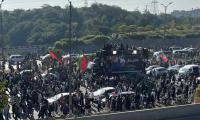We have lost two prime ministers and quite a few political leaders to assassins’ bombs and bullets. The bullet that hit Ahsan Iqbal was a different kind of projectile, marking the beginning of a new era of extremism in Pakistan. There are reasons to believe that this new face of extremism can be scarier than anything we have seen so far.
Since 1977, religious extremism in Pakistan has been associated with three factors: sectarianism, the Afghan jihad and the Kashmir jihad. Sectarian fault lines became important after the Iranian revolution, when both Iran and Saudi Arabia were allowed to carry out their ‘public diplomacy’ in Pakistan through supporting militant sectarian outfits.
Sectarianism and the Afghan jihad were closely linked because of the Saudi support and the nature of militant organisations. All jihadi outfits were organised along sectarian lines. It was due to Saudi insistence perhaps that no Shia or Barelvi jihadi organisation of Pakistani origin was created to engage in the Afghan jihad.
Sipah-e-Sahaba, the Deobandi sectarian militant organisation that started its journey in 1985 from Jhang in Punjab, played an important part in linking sectarian violence with the Afghan jihad. Riaz Basra, who created a splinter militant group, the Lashkar-e-Jhangvi, was based in Kabul when the Taliban government was overthrown in 2001. In 1999, just before his government was overthrown, Nawaz Sharif had put the Taliban government on notice for harbouring Basra and his terrorist group, who were massacring people in Pakistan. Kashmir was another front for many militants who had nothing to do after the Afghan jihad ended and the Afghan mujahideen turned their guns upon each other.
One element that remained missing from the recipe all along was violent Barelviism. There was the Sunni Tehreek in Karachi, but it remained confined to the city and tried to copy the style of the MQM without much success.
The Pakistani middle class theorised it in terms of the split between two types of Islam: the violent clerical version of Wahhabi Islam and the tolerant Sufi/Deobandi Islam. This is a false dichotomy. The Deobandi sect is deeply influenced by Sufi practices and the Barelvi sect is not just another name for Sufi Islam.
It is a very Orientalist method of analysis to find the roots of religious militancy in religious text ie religious ideology. Modern political violence, both religious and secular, is largely rooted in identities, not ideologies. It is a modern phenomenon. How ideologies are linked to identities and how organisations turn young recruits to violence are the most important questions to explore.
Barelvi religious organisations had been peaceful because they were not invited to the jihadi party despite their best wishes. Maulana Shah Ahmad Noorani, an influential Barelvi political leader and head of Jamiat Ulema-e-Pakistan used to openly complain about this ‘discrimination’.
The time for complaints is over. The age of assertive, violent Barelviism has started. In Greek mythology, King Sisyphus is by punished by the gods for his craftiness and deceitfulness by being forced to roll a huge boulder to the top of a hill only for it to roll down when it nears the top; he is condemned to repeat this action for eternity.
We may not be kings and we may not be too crafty but it appears that there is no escaping the weight of the boulders that we must carry in the name of our faith. We have barely crept out of the old form of extremism after 30 years of chaos and we find ourselves face to face with a new form of extremism. This form of extremis can be far more dangerous than earlier manifestations of religious violence in Pakistan because it is rooted more organically with our society and politics.
The Tehreek-e-Labbaik marks the beginning of a new brand of religious politics that celebrates and promotes religious violence. It enjoys more power to influence state and public policy. During 2017, we witnessed the reversal of a thirty-year-old process of the mainstreaming of the religious vote bank. This process had started with the formation of the Islami Jamhoori Ittehad in 1988, headed by Nawaz Sharif. When religious parties left the alliance, the religious vote bank stuck with Nawaz Sharif and kept voting for the PML-N. This process continued even when the PML-N moved from the right of the centre to the centre and became a centrist party. More recently, the PTI was also able to attract religious vote bank because of its extreme right political position.
The by-election held in 2017 saw a section of the religious vote bank reverting to the new religious outfits, particularly the Tehreek-e-Labbaik. It showed an impressive performance in Lahore, Peshawar, Chakwal and Lodhran. The votes gained by the Tehreek-e-Labbaik ranged between 6 and 8 percent. In NA-4 Lahore, the PML-N’s loss was proportionate to the gain by the new religious political parties (the other being the Milli Muslim League of Hafiz Saeed). In Chakwal, the Tehreek-e-Labbaik appeared to have hurt the PTI. The Tehreek-e-Labbaik remains a wild card for the 2018 elections and it is hard to predict how it will influence the outcome of the polls.
Though the PTI has welcomed the Tehreek-e-Labbaik as a weapon against the PML-N, it is the PTI and its educated middle-class voters who are going to suffer the most from this new brand of religious extremism. Pakistan’s ruling educated middle class elite that is rooted in the Aligarh movement sits more easily with the Deobandi sect. The alliance between Deoband and Aligarh was forged during the life of Sir Syed Ahmad Khan and has endured ever since.
The Sajjada Nasheens, who are largely part of the traditional elite in Pakistan, provided a mediating link between the Barelvi population and the state. The Tehreek-e-Labbaik questions the credibility of the rich Sajjada Nasheens and rejects their right to speak on behalf of the Barelvis.
Barelvis have a huge following among the working class and their economic marginality coincides with the religious grievance. Barelvis feel aggrieved that the state treats them differently from Deobandis. Khadim Hussain Rizvi has been able to articulate this grievance through a religious idiom. He has opened a seductive path of empowerment that leads to anarchy.
While old-style organisations promoted private jihad, the Tehreek-e-Labbaik promotes the right of the individual to resort to violence for the sake of faith. It is a huge step forward (or backward) if you like.
The man who attacked the interior minister was affiliated with the Tehreek but not directed by the organisation to commit the act of violence. This is far more dangerous than the more organised violence of the militant organisations we have endured so far. It gives the Tehreek-e-Labbaik plausible deniability while benefitting from the terror spread by its followers. Very soon, we may see the emergence of new copycat organisations trying to beat Khadim Hussain at his game. Welcome to Naya Pakistan. It is time to carry our boulder back to the top.
The writer is an anthropologist and development professional.
Email: zaighamkhan@yahoo.com
Twitter: @zaighamkhan
Proliferation of these platforms denotes an important reality for readers in underserved regions
Government decided to crack down decisively with result protest was over by early morning on Nov 27
This is critical time for Pakistan to reconsider its growth trajectory and align with international trends
Khawarij are notorious for extremist proclamations branding anyone who disagreed with their views as heretics
Most SOEs such as PIA, may have a negative net worth too, based on their earnings potential
Fortunately, after a decade’s struggle with smog, Pakistani Punjab has understood the urgency of climate action







